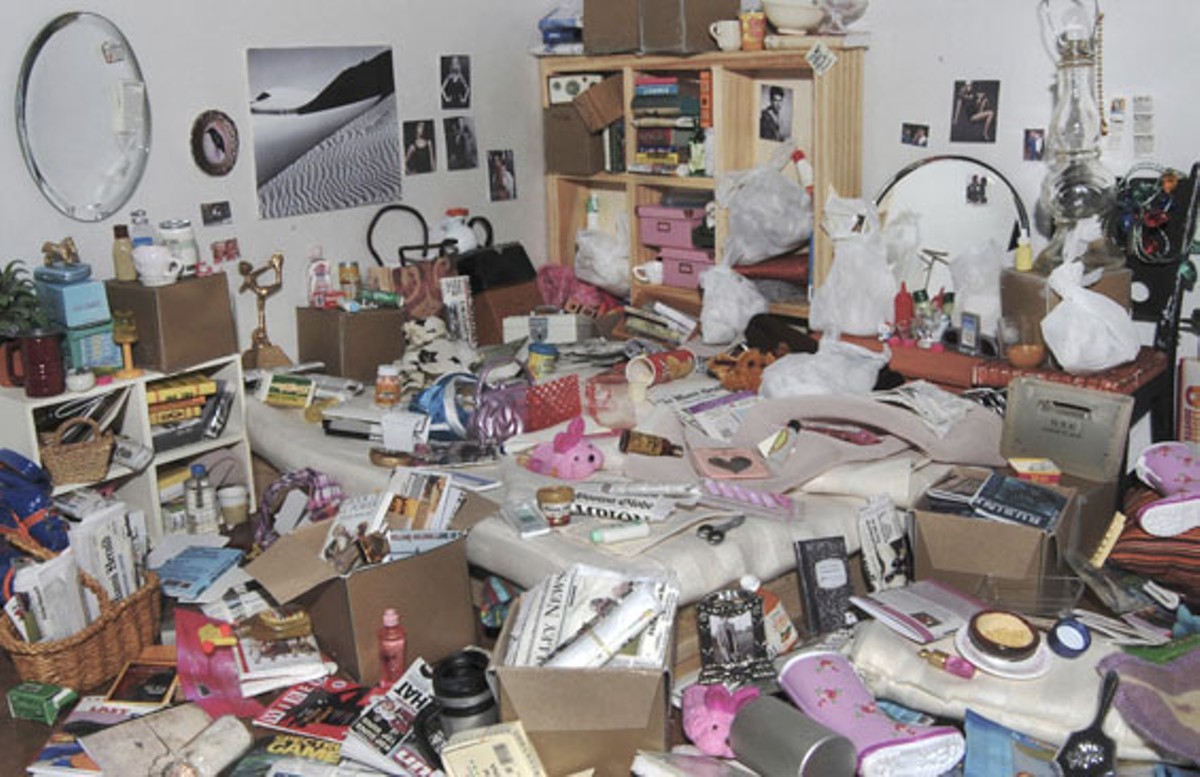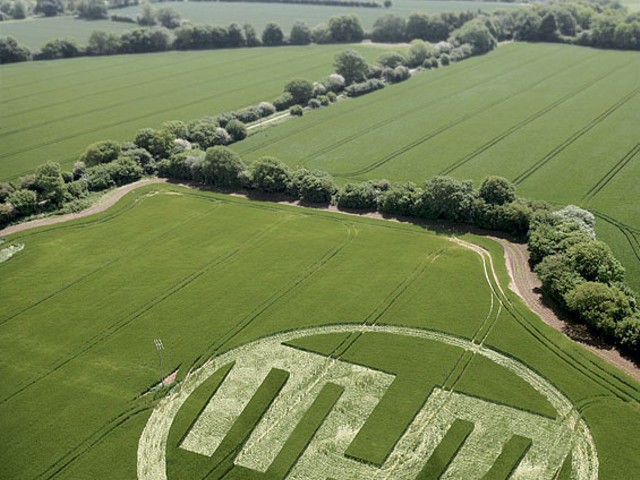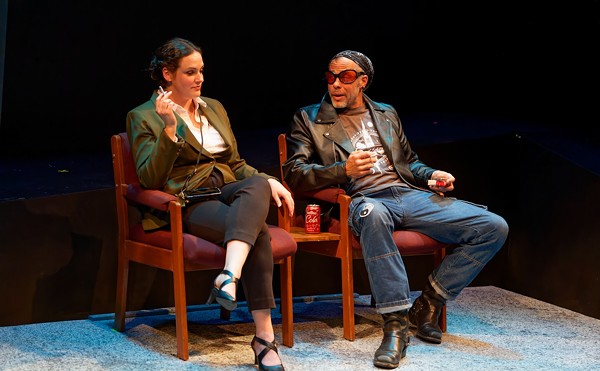For Carrie M. Becker 2012 has been every unknown-artist's dream. In early January her photo series Barbie Trashes Her Dream House, a collection of dollhouse-scale rooms Becker had painstakingly constructed and then photographed to make them appear life-size, went viral.
Viewers were attracted to the concept of Barbie, that iconically perfect princess, as secretly a filthy hoarder, but the work's true brilliance lay in Becker's intricately constructed dioramas, detailed right down to the tiny turds in Barbie's unflushed toilet, and the bland, documentary composition of the photographs, as dispassionately rendered as snapshots taken with a cheap point-and-shoot. They looked real, in other words. And, therefore, all the more disturbing.
Becker's Flickr page received more than 100,000 hits in a single day, and when the dust cleared months later, her work had been featured in more than 60 media outlets (in eighteen different languages), including Time.com, Jezebel, Huffington Post, the Daily Beast, Bust and Scientific American, where some of the photos were used to illustrate a feature about optical illusions. The photo series is now on view in a shopping mall in Shanghai, China.
"I'd go to a Chinese site and, holy shit — there's my work!" Becker recalls. "I'd click on Google Translate to read it. Here you're a nobody, literally, on a Thursday, and then on Friday by noon 120,000 people have seen your work. You can't plan for that."
In February at the Gallery of Contemporary Art at St. Louis Community College–Forest Park, Becker reprised Elements, a series of installations based on images from scanning electron microscopes, which she'd created and exhibited while an artist-in-residence at the McColl Center for Visual Art in Charlotte in the fall of 2011.
In March Becker turned 34. In April she gave a visiting-artist lecture at Eastern Kentucky University. In May she married comedian Christian Lawrence, a co-founder of Bare Knuckle Comedy who spends his days as an Apple Store "genius," and the couple moved into ArtLofts, a building on Washington Avenue that offers rent subsidies to working artists. In November a solo show of the Barbie series will open at the Riney Fine Arts Gallery at Friends University in Wichita.
But as with her work, there has been more to Becker's fabulous year than the highlight reel that meets the eye, The same week Barbie went viral, Forest Park, where she has taught as an adjunct since earning her MFA from Kansas State University two years ago, canceled one of the two classes she was scheduled to teach, owing to lack of enrollment. The school canceled a summer class, too. In order to make rent, Becker took a job as an administrative assistant at a roofing company. Last month the roofers went out of business. Forest Park doesn't have a class for her for the coming semester, and Becker isn't sure how she'll be able to raise the $2,000 she estimates it'll cost to get Barbie printed and framed for the Riney.
Unemployment tends to give one time to reflect.
"If your work is being seen and appreciated by 100,000 people — that's good, right?" Becker wonders aloud. "Does that mean I'm a professional artist, if people like it? What if you don't get paid for it? Does that make you a professional artist who makes zero dollars per year?"
She knows her work is a tough sell. There's no money in installations — who has the space to display them, and why would anyone buy a photo of Barbie's shit-filled toilet to hang on their wall?
This is not what Becker envisioned when she decided as a sixteen-year-old that she wanted to pursue a career in art. For four years in her twenties, she worked as a commercial photographer in Chicago and assisted on furniture shoots for the Sears catalog. The experience resurfaced as inspiration for the Barbie series, but at the time Becker found it soul-crushing. She enrolled in grad school, planning to earn her MFA and then work her way onto a college art faculty.
At school Becker rediscovered the sense of whimsy that made her want to do art in the first place. She gravitated to mixed-media sculpture, messing around with fabrics and textures and indulging her fondness for repeating shapes, à la cells viewed through a microscope. In her third and final year, she began schlepping her pieces out to abandoned farmhouses on the Kansas prairie. The resulting photos depict pink corpuscles exploding from cracked walls, spermlike shapes swimming through broken blinds, ropes of moss creeping down a chimney to take over a deserted living room.
"Her final exhibit was extraordinary," recalls Gerry Craig, director of Kansas State's art department and a member of Becker's thesis committee. "It's unusual for people to take objects and photograph them in a place that has character of its own. The crustiness of the Kansas farmhouses is a lot to take on visually, and to insert your own work makes it even more difficult. It plays with reality in a way that's very contemporary."
Adds Melissa Vandenberg, an assistant professor of art at Eastern Kentucky: "I'm impressed with her restraint in not giving up her secrets right away."
Michael Drummond, a fashion designer who appeared on Project Runway and who has been a friend of Becker since their days at McCluer High School, accompanied her on a few of her farmhouse forays. "We'd spend hours exploring other people's lives," he recalls. "They were like little plays. We'd create a story about the people who had lived there."
Drummond sees this same impulse — on an obverse scale — in Becker's Barbie, which began in a burst of post-thesis exhaustion combined with a subconscious filled with images from episodes of the BBC program How Clean Is Your House? and a long-time obsession with ReMent, a Japanese company that makes models of household objects at 1/6 scale. Becker's Barbie is an unseen but definite presence. You wonder how she could let the Dream House fall into such disrepair — what would Ken think? — and then you remember that it's only a series of photographs playing with your perspective.
For the record, Becker added the Barbie conceit only after some viewers at McColl, convinced they were looking at photos of her own house, suggested she seek help. Becker is scrupulously neat; she keeps all her ReMent props carefully stowed in bankers boxes beneath the worktable in her studio.
Earlier this summer at the Goodwill store in Brentwood, Becker stumbled across a 1/6-scale model of a townhouse that looks like the ones that proliferate in Soulard and Lafayette Square. It seemed providential. The dollhouse now occupies a corner of her loft, where she has been remodeling it with ugly wallpaper and brown felt reminiscent of decrepit Berber carpet. Trashing is still to come, followed by a Plexiglas fourth wall. At the moment she's photographing the house as it would appear at different times of day.
The work may sound tedious, but Becker revels in the actual process of making art. "As a kid I glued bits of sequins to a piece of paper to make an ombre pattern, except I didn't realize it was called that at the time," she says. "I love to go off and goof around without having an idea about how it will relate to 'Art.' It's just being creative. You're cutting up six-by-six-inch pieces of gauze dipped in yellow wax and shaping them into cylinders, and you do this literally a million times. And it sounds stupid as all hell until you see it standing on the floor. Then it's a crazy amoeba and it's not one color, it's thousands of shades of yellow!"
She laughs. "It's like play time all over again."
Click here to see more of Becker's work.
Click to return to our list of 2012 MasterMind Award winners.






